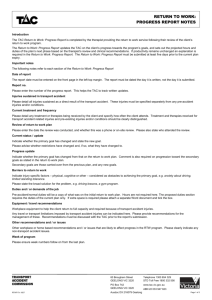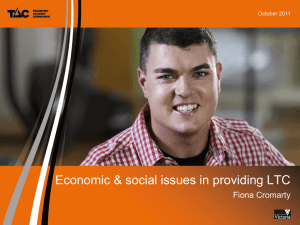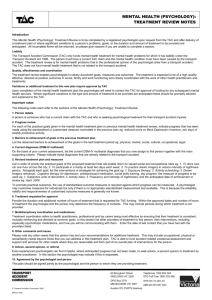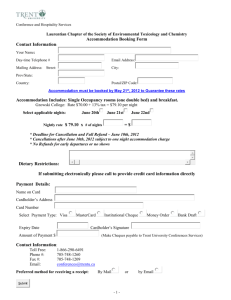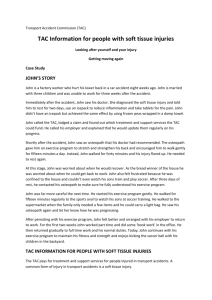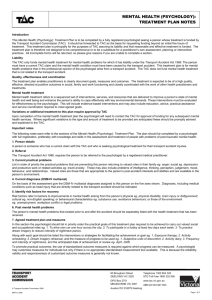Important notes for completing the treatment notification plan
advertisement
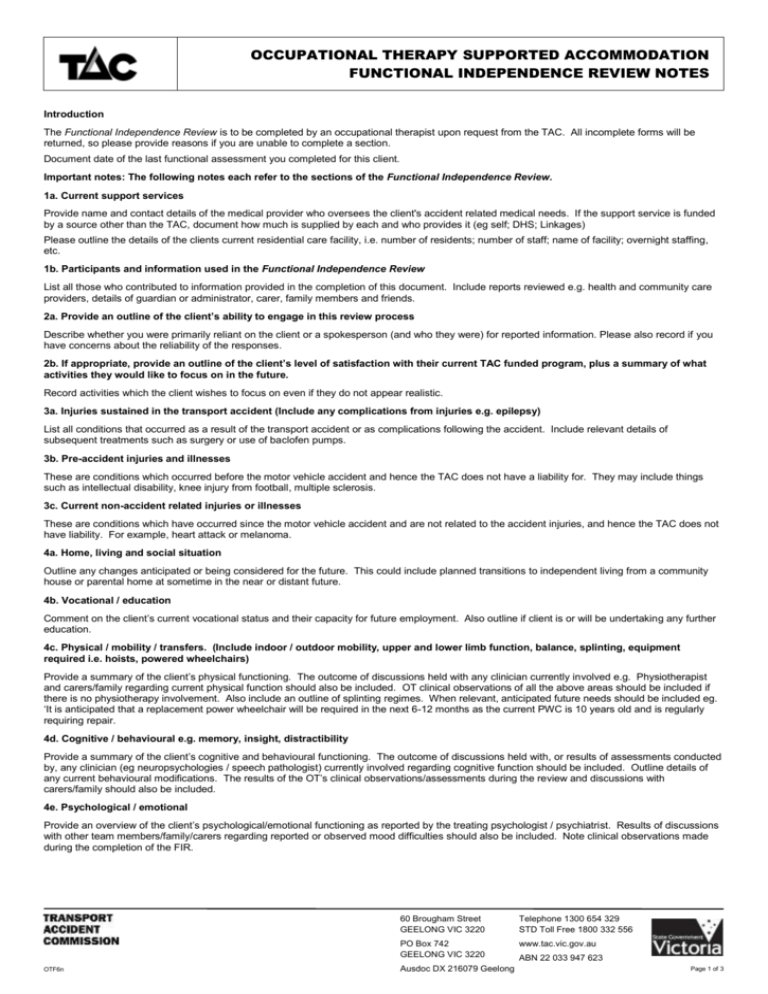
OCCUPATIONAL THERAPY SUPPORTED ACCOMMODATION FUNCTIONAL INDEPENDENCE REVIEW NOTES Introduction The Functional Independence Review is to be completed by an occupational therapist upon request from the TAC. All incomplete forms will be returned, so please provide reasons if you are unable to complete a section. Document date of the last functional assessment you completed for this client. Important notes: The following notes each refer to the sections of the Functional Independence Review. 1a. Current support services Provide name and contact details of the medical provider who oversees the client's accident related medical needs. If the support service is funded by a source other than the TAC, document how much is supplied by each and who provides it (eg self; DHS; Linkages) Please outline the details of the clients current residential care facility, i.e. number of residents; number of staff; name of facility; overnight staffing, etc. 1b. Participants and information used in the Functional Independence Review List all those who contributed to information provided in the completion of this document. Include reports reviewed e.g. health and community care providers, details of guardian or administrator, carer, family members and friends. 2a. Provide an outline of the client’s ability to engage in this review process Describe whether you were primarily reliant on the client or a spokesperson (and who they were) for reported information. Please also record if you have concerns about the reliability of the responses. 2b. If appropriate, provide an outline of the client’s level of satisfaction with their current TAC funded program, plus a summary of what activities they would like to focus on in the future. Record activities which the client wishes to focus on even if they do not appear realistic. 3a. Injuries sustained in the transport accident (Include any complications from injuries e.g. epilepsy) List all conditions that occurred as a result of the transport accident or as complications following the accident. Include relevant details of subsequent treatments such as surgery or use of baclofen pumps. 3b. Pre-accident injuries and illnesses These are conditions which occurred before the motor vehicle accident and hence the TAC does not have a liability for. They may include things such as intellectual disability, knee injury from football, multiple sclerosis. 3c. Current non-accident related injuries or illnesses These are conditions which have occurred since the motor vehicle accident and are not related to the accident injuries, and hence the TAC does not have liability. For example, heart attack or melanoma. 4a. Home, living and social situation Outline any changes anticipated or being considered for the future. This could include planned transitions to independent living from a community house or parental home at sometime in the near or distant future. 4b. Vocational / education Comment on the client’s current vocational status and their capacity for future employment. Also outline if client is or will be undertaking any further education. 4c. Physical / mobility / transfers. (Include indoor / outdoor mobility, upper and lower limb function, balance, splinting, equipment required i.e. hoists, powered wheelchairs) Provide a summary of the client’s physical functioning. The outcome of discussions held with any clinician currently involved e.g. Physiotherapist and carers/family regarding current physical function should also be included. OT clinical observations of all the above areas should be included if there is no physiotherapy involvement. Also include an outline of splinting regimes. When relevant, anticipated future needs should be included eg. ‘It is anticipated that a replacement power wheelchair will be required in the next 6-12 months as the current PWC is 10 years old and is regularly requiring repair. 4d. Cognitive / behavioural e.g. memory, insight, distractibility Provide a summary of the client’s cognitive and behavioural functioning. The outcome of discussions held with, or results of assessments conducted by, any clinician (eg neuropsychologies / speech pathologist) currently involved regarding cognitive function should be included. Outline details of any current behavioural modifications. The results of the OT’s clinical observations/assessments during the review and discussions with carers/family should also be included. 4e. Psychological / emotional Provide an overview of the client’s psychological/emotional functioning as reported by the treating psychologist / psychiatrist. Results of discussions with other team members/family/carers regarding reported or observed mood difficulties should also be included. Note clinical observations made during the completion of the FIR. OTF6n 60 Brougham Street GEELONG VIC 3220 Telephone 1300 654 329 STD Toll Free 1800 332 556 PO Box 742 GEELONG VIC 3220 www.tac.vic.gov.au Ausdoc DX 216079 Geelong ABN 22 033 947 623 Page 1 of 3 OCCUPATIONAL THERAPY SUPPORTED ACCOMMODATION FUNCTIONAL INDEPENDENCE REVIEW NOTES 4f. Communication / swallowing Provide a summary of the client’s verbal and written expressive and receptive skills as reported by the treating speech pathologist. Comments regarding any swallowing issues should also be included. If no speech pathologist is involved comment on feedback from family/carers and clinical observations regarding functional communication and swallowing made during the review. 5. Skills and support Please complete table fully. 6. Summary of activities. These tables are designed to identify the amount of support time required for a client to perform their ADLs. Please consider whether the assistance required is deliverable by supported accommodation or if additional care required. If the answer under ‘Is support provided by the supported accommodation facility’ is “No” please complete the “Current Hours” and “Recommended Hours” columns. Functional Level - Should be stated to be one of the following: fully dependent, requires assistance or fully independent. The client's lowest level of function should be reflected in this table. The tasks need to be broken down into sub-tasks as is appropriate for the individuals. Note that if a client requires supervision then this should be marked as 'requires assistance.' If the client requires equipment to be safe and independent during the completion of a task, they should be reported to be “fully independent.” If they require equipment and supervision, they should be reported to “require assistance.” Further detail can be provided in the comments section. Type of assistance required One of the following categories should be chosen: physical assistance, verbal prompting, set-up and supervision, set-up only, supervision only, monitoring (attendant carer occasionally checks a client to ensure that the client completes the task in a safe and timely manner.) The attendant carer should complete other tasks while monitoring a client. Choose the highest level of assistance required. Extra detail can be provided in the comments section if required. Recommended hours Hours should be recorded as number of hours per week unless otherwise specified. Where appropriate include a breakdown of number of hours required per day. The spread of these hours will also be demonstrated in the future weekly planner. Are there measurable therapy goals in this area? This relates to identifying areas where the client has the capacity to improve their functional independence. 6a Comments regarding personal care activities Include a thorough outline of the client's current status during all personal care and domestic activities. Please include information regarding equipment, adaptive strategies and type of support required during these tasks. Comment on whether the support provided is for rehabilitation purposes or to provide assistance to clients for tasks that they are unable to perform. For all tasks requiring assistance / support please complete the table. Provide justification for why the client requires the level of assistance outlined e.g. do they require supervision as a result of reduced balance or as a result of cognitive impairment such as impulsivity. 6b Comments regarding domestic activities Include any domestic tasks that the client participates in and the nature of the activity. 6c. Comments regarding community status Include an outline of the client's current status during community activities and their ability to access the community. Please include information regarding the most appropriate services available in the community and the person’s ability to transport themself. Outline current or future use of community group program (CGPs). Consider whether or not shared care would be an appropriate option for community activities. Assistance required for facility based recreational activities should be included in this section. 6d. Comments regarding vocational / education / therapy support / self management / organisation status Include an outline of the client's current status during vocational / education / therapy / self management / organisation activities. Please include information regarding equipment, strategies and type of support required during these tasks. Comment on whether the support provided is for rehabilitation purposes or to provide assistance to client's for tasks that they are unable to perform. For all tasks requiring attendant care / Allied Health Support please complete the table. 6e. Overnight support requirements. Please outline the clients overnight support requirements and include alternatives trialled to address issues. Please specify nature of assistance required if requesting active overnight sleepovers 6f. Supported Accommodation Please comment on the clinical justification for the clients’ requirement for ongoing supported accommodation. 7. Proposed weekly planner Indicate where TAC funded supports are used during the week including 1:1 attendant care, therapy support, community group programs, etc. Total hours for each service type per day and week should be included. Also include the total number of hours the client is absent from the supported accommodation. 8. Comments, summary and/or recommendations Provide any other information you believe is relevant. OTF6n Page 2 of 3 OCCUPATIONAL THERAPY SUPPORTED ACCOMMODATION FUNCTIONAL INDEPENDENCE REVIEW NOTES 9. If you are requesting ongoing OT services, this section must be completed. Review service plan goal table: The goals from the previous OT service plan or FIR need to be outlined, including a summary of the client’s progress towards increased independence. Whether or not the goal has been achieved or not needs to be stated. No alternative responses such as “partially achieved” should be included in this column. Reasons/barriers to goal achievement should also be outlined. This section should provide justification for the decision to either re-set a goal in the same functional area in the subsequent set of goals, or for withdrawing goal setting in that specific area. Functional goal including measurable outcome: This should include the functional area to be addressed and how change over time is to be measured. Measures may include standardised outcome measures, rating scales (client, clinician and other ratings) and documented change from baseline observations at the commencement of intervention or at the time of the previous service plan. For example: Client will require supervision only with lower body dressing tasks by 31/3/2007. Number of hours: Outline the anticipated total number of hours of OT services required to address the specified goal over the period of funding being requested. Outline the total number of hours the client is away from the facility. Client authorisation Please ensure you discuss this Functional Independence Review with the client or their representative (guardian and administrator). OTF6n Page 3 of 3
